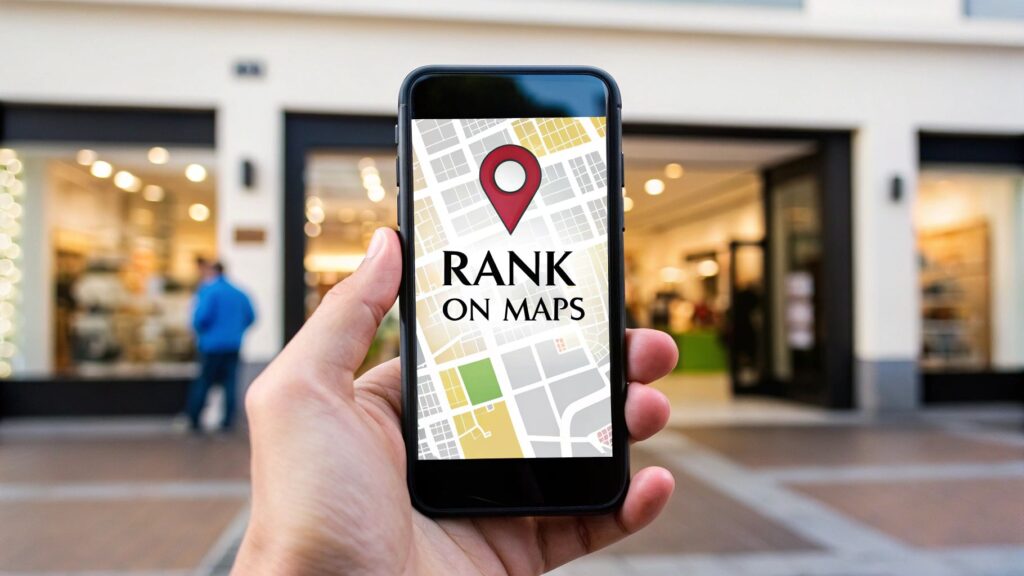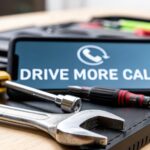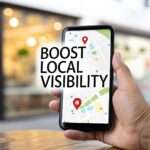Let's be clear. When we talk about SEO for auto repair shops, we're not using fancy tech jargon. We're talking about getting your shop to show up first when a driver in your neighborhood Googles "brake repair near me" or "why is my car making a weird noise?"
It’s about making sure your phone rings, not the one down the street. It’s that simple.
In Short: Good SEO makes your auto repair shop the first choice for local drivers searching online for help.
Why Your Garage Needs a Digital Tune-Up
The days of relying on the Yellow Pages are long gone. Your next customer is probably in their car right now, searching on their phone. That check engine light just came on, and their first move is to search online.
This isn't a trend; it's how people find services now. If your shop doesn't appear in search results, you're invisible to most people who need you. You could be the most skilled mechanic in the state, but if Google doesn’t know you exist, you’re not getting the business.

From Word-of-Mouth to Search Engine Clicks
Word-of-mouth is still important. But today, it looks different. It’s a 5-star Google review. It’s showing up at the top of search results.
Think of SEO as digital word-of-mouth that works 24/7. It puts your shop in front of local drivers who are actively looking for a mechanic. A smart SEO plan grabs the attention of people with an immediate problem. This is a key part of any modern https://clicksgeek.com/marketing-plan-auto-repair-shop/.
Let’s look at how people find mechanics now compared to the old days.
How Customers Find Mechanics: Old vs. New
| Customer Action | Traditional Method (Pre-Internet) | Modern Method (Digital First) |
|---|---|---|
| Initial Search | Flips through the Yellow Pages | Searches "auto repair near me" on Google or Maps |
| Vetting Options | Asks a friend or neighbor for a recommendation | Reads online reviews and checks star ratings |
| Making Contact | Looks up the number and makes a call | Clicks the "Call" button or books online directly |
| Getting Directions | Uses a paper map or asks for landmarks | Taps for GPS directions straight to the shop's door |
The takeaway is clear: the customer journey starts online.
The High Stakes of Online Visibility
By 2025, it's expected that 95% of car buyers will start their search online. This behavior carries over to car service. If you’re not online, you’re not in the game.
Your competition isn't just other local shops. It's the shops that are good at showing up on Google. Getting your SEO right is a direct investment in winning local business.
Here's what a solid online presence gets you:
- More Phone Calls: Showing up in local search means more calls from people ready to book.
- Builds Trust: A professional website that ranks well is seen as more trustworthy.
- Smarter Marketing Spend: Good SEO brings in a steady stream of traffic without constant ad payments.
- Drives Customers to Your Door: A high ranking on Google Maps guides drivers to your service bays.
Putting effort into your shop's SEO is like a tune-up for your business. It ensures you're pulling ahead of the competition.
Dominating the Local Map Pack
When a car breaks down, the driver searches on their phone for "mechanic near me." The shops that appear in the map box at the top of Google get the call.
This is the goal of local SEO for auto repair. Your most important tool is your Google Business Profile (GBP).
Think of your GBP as your digital first impression. An outdated profile suggests you don't pay attention. But a detailed, active profile tells Google and customers you’re a professional shop ready for business.
Your Google Business Profile Is a Must-Have
Optimizing your GBP is more than just listing your name and address. The details are what make your phone ring. You need to fill out every section Google provides. This includes hours, website, phone number, and a clear business description.
The goal is to give potential customers a complete snapshot of your business that answers their questions instantly.
This image shows how your website's on-page SEO improves your visibility in the local map pack.

As you can see, a solid website sends the right signals to your Google Business Profile. This creates a powerful combination that Google rewards.
Fine-Tuning Your Profile for Real Impact
To get ahead of the competition, use every feature GBP offers. This is your chance to show your expertise and build trust.
Here's where to focus:
- Services and Categories: Be specific. Instead of "Auto Repair Shop," add "brake jobs," "oil changes," and "check engine light diagnostics." The more specific you are, the easier it is for Google to match you with a search.
- High-Quality Photos: Post clear, recent photos of your bays, your team, and your equipment. It helps people see you run a professional operation.
- Google Q&A: Answer common questions before they are asked. Use the Q&A feature to ask and answer things like, "Do you offer a warranty on your repairs?"
- Google Posts: Think of this as a mini-blog. Share updates, post a coupon, or offer a quick tip. It shows Google your profile is active.
🔑 In Short: A complete and active Google Business Profile is the biggest factor in ranking in the local map pack.
Building Your Digital Footprint with Citations
Google also checks if your business information is consistent across the web. This is where local citations are crucial. A citation is any online mention of your shop's Name, Address, and Phone number (NAP).
This includes directories like:
- Yelp
- Angi
- Yellow Pages
- Other auto-specific directories
It is critical that your NAP is identical on every site. A small difference, like "St." versus "Street," can confuse Google and hurt your rankings. Consistency signals that you're a legitimate business.
People Also Ask About Auto Repair SEO
Here are a few common questions shop owners have about local SEO.
How do I get my auto repair shop to show up on Google Maps?
Start by claiming and fully optimizing your Google Business Profile. Fill out every section, add specific services, upload high-quality photos, and encourage customers to leave reviews. This is the foundation for visibility on Google Maps.
Should I list my home address for my mobile repair business?
No. If you're a mobile mechanic, set up a "service area business" in your GBP. This hides your home address and instead shows customers a map of the areas you serve, which is what they need to know.
How can I get more reviews for my mechanic shop?
Just ask. The easiest way is to create a direct link to your Google review page. Text it to a happy customer right after you finish their service. Making it simple increases the chances they will leave feedback.
Local search is essential. Data shows that 46% of car buyers look online for local services. A well-managed Google Business Profile is your best tool to capture them. This strategy is also vital for other trades; plumbers, for example, rely on optimizing for 'near me' searches to get their phones to ring.
Finding the Right Keywords for Your Services
The core of SEO for auto repair is understanding what a stressed driver types into Google. If you can identify those exact phrases, you can place your shop directly in their path.
They aren't searching for "expert automotive solutions." They’re typing things like "why is my car overheating" or "how much for a new alternator." Your job is to find these search terms and build your website around them. This is called keyword research, and it’s the foundation of any good SEO plan.

You don't have to guess. Tools like Google's Keyword Planner show you what people are searching for and how often. This data provides a clear roadmap to attract customers.
Understanding the Three Main Keyword Types
Potential customers search in different ways depending on their needs. To reach them all, target three types of keywords.
- Specific Service Keywords: These are high-intent keywords. The person searching knows what's wrong and is looking for a shop.
- Vehicle-Focused Keywords: Smart drivers include their car's make and model to find a specialist.
- Problem-Based Keywords: This is the starting point. The driver uses Google for a diagnosis before looking for a repair shop.
By targeting all three, you meet customers at every step of their journey.
How to Find High-Value Service Keywords
Service-based keywords are your most valuable targets. These searches often include terms like "repair," "replacement," "cost," or "near me."
Start by listing every service you offer. Get specific.
- Instead of "brake work," target "brake pad replacement cost."
- Rather than "engine repair," go for "check engine light diagnostic."
- Instead of "A/C service," use "car AC recharge near me."
These longer phrases are called long-tail keywords. They have less competition and attract customers who are ready to book an appointment. You can learn how to use Google's keyword tool planner to find them for free.
Targeting Vehicle and Problem-Based Searches
Next, focus on the specific cars you service. People trust shops that specialize in their make and model.
🔑 Pro Tip: Create separate pages on your website for popular vehicles you service. A page titled "Honda Civic Brake Repair in [Your City]" will perform much better for that search than a generic "Brake Repair" page.
Examples of vehicle-focused keywords:
- "Ford F-150 oil change near me"
- "Toyota Camry timing belt replacement"
- "Jeep Wrangler transmission repair"
Finally, capture the "what's wrong with my car?" crowd with problem-based keywords. These are usually questions.
- "Why is my car shaking when I brake?"
- "What does a grinding noise mean?"
- "Car won't start but lights come on"
Answer these questions in a blog post or an FAQ section. This positions you as a helpful expert. When they figure out the problem, they'll be more likely to call your shop.
Your Website: The 24/7 Service Advisor
Your website works around the clock. Its job is to convince a car owner that your shop is the right choice. A great website builds trust and makes booking a service easy.
The goal is to turn your site into a lead-generation machine. This is the foundation of any real SEO for auto repair strategy.
The Essential Pages Every Shop Website Needs
A simple website is often more effective. You just need a few core pages that give customers what they’re looking for.
- Homepage: Your digital front door. It must instantly tell people who you are and what you fix.
- Service Pages: Create dedicated pages for "Brake Repair," "Oil Changes," and your other main services. Don't lump them all together.
- About Us Page: This is where you connect with customers. Show off your team's experience and personality.
- Contact Page: Make it easy for people to find you. Include your address, phone number, a map, and your hours.
First Impressions: Nailing the Homepage
You have about three seconds to make a good impression. Your homepage must be clean, professional, and easy to navigate.
From the moment your site loads, a visitor needs to see:
- Your phone number, big and clickable.
- A clear headline like "Honest Auto Repair in Springfield."
- An obvious "Book an Appointment" button.
- Social proof, like your best Google reviews or ASE certifications.
Keep it simple. Show a potential customer they've found the right place to solve their problem quickly.
🔑 In Short: Your customer may be searching from the side of the road. If your website is slow or clunky on a smartphone, you’ve lost their business.
Turning Service Pages into Booking Magnets
A generic "Our Services" page doesn't convert well. You need a separate page for each major service you offer. This helps you rank for specific searches like "alternator replacement cost."
What should go on these pages?
- A description of the service.
- Common symptoms people experience (e.g., "squealing when you brake").
- A quick rundown of your repair process.
- A clear call to action, like "Schedule Your Free Brake Inspection Today."
Each service page is a specialized sales pitch. Providing helpful info establishes you as an expert.
The About and Contact Pages: Where You Seal the Deal
Don't skip the "About Us" page. People want to do business with people, not a logo. Introduce your lead techs and tell your shop's story.
Finally, make your contact page foolproof.
- Embed a Google Map.
- List your hours clearly.
- Make sure your phone number is a "click-to-call" link.
Removing every obstacle makes it easier for a customer to contact you. A well-built website is the engine that drives your online marketing.
Turning Online Reviews into Your Best Marketing Tool
In the auto repair business, trust is everything. Online reviews are the new word-of-mouth and play a massive role in your shop's SEO.
A steady stream of positive reviews signals to Google that your shop is legitimate and trustworthy. This directly boosts your chances of showing up in the local map pack. Reviews also give new customers the social proof they need to feel confident in choosing you.
How to Get More Customer Reviews Without Being Pushy
Most happy customers are willing to leave a review. They just forget. Your job is to make it simple for them.
Here's a simple approach:
- Make a Direct Link: Use a free tool to create a direct link that takes customers straight to the review pop-up for your Google Business Profile.
- Send a Quick Text: When a customer pays, send a friendly text. Something like, "Hey John, thanks for trusting us with your truck today! We'd love your feedback: [your direct link]."
- Use QR Codes: Place a QR code on your front desk or invoice. It's a low-pressure way for customers to leave a review while they wait.
The goal is to remove all friction. The easier you make it, the more likely you'll get that 5-star rating.
Responding to Every Single Review—The Good and The Bad
Ignoring reviews is a missed opportunity. When you respond, you show everyone that you're an engaged owner who cares. This is great for customer service and your SEO.
🔑 Key Insight: A 2025 case study from a local auto body shop illustrated the powerful impact of SEO on business growth: by implementing targeted SEO strategies, the shop experienced an impressive 103% increase in organic search traffic within six months. This shows how a well-rounded strategy, including active review management, leads to real growth. You can discover more insights about this case study on StiganMedia.com.
What's the right way to handle a bad review?
A negative review can be tough, but your response can demonstrate your professionalism. Don't get defensive. Respond quickly, acknowledge their frustration, and offer to take the conversation offline to fix the issue.
How do you professionally respond to a positive review?
Responding to good reviews is just as important. It reinforces the great experience. Ditch the generic "Thanks!" and be personal. If you remember the job, mention it. "Glad we could get those new brakes on for you, Sarah!" goes a long way.
This table is a quick guide for responding to reviews.
How to Respond to Customer Reviews
| Review Type | Key Elements of a Good Response | Example Snippet |
|---|---|---|
| Positive | Thank the customer by name, mention a specific detail, and invite them back. | "Thanks, Sarah! We're so glad we could get your AC running cold again. We look forward to seeing you for your next oil change!" |
| Negative | Acknowledge their issue, apologize for their experience, and offer to resolve it offline. | "Hi Mike, we're sorry to hear you were not satisfied with your recent visit. Please call me directly at [phone number] so we can make this right." |
| Neutral | Thank them for their feedback and address any points they made, showing you're listening. | "Thanks for the feedback, David. We appreciate you pointing that out and will use your comments to improve our process. We hope to serve you again." |
Engaging with reviews shows potential customers that you'll step up to fix any issues. That builds incredible trust.
Got Questions About Auto Repair SEO? We’ve Got Answers.
Jumping into SEO can feel overwhelming. Let's clear up some of the most common questions from shop owners.
How long does it take for SEO to work for an auto repair shop?
It takes time. You might see some early results on Google Maps within a few weeks after optimizing your Google Business Profile.
For bigger goals, like ranking at the top for competitive keywords, plan for 4-6 months of consistent work.
Factors that affect this timeline include:
- Local Competition: A busy city will take longer than a small town.
- Website History: An older, established site often gains traction faster.
- Consistency: SEO is not a one-time task. Regular updates are key.
Patience is crucial. Small, steady efforts will lead to impressive results.
Can I do SEO for my own auto repair shop?
Yes, you can. Much of local SEO is about knowing your business and customers, not being a tech expert.
This guide covers high-impact tasks you can do yourself:
- Optimize Your Google Business Profile: You know your business details best.
- Build Out Service Pages: Explain your services simply, as you would to a customer.
- Get More Customer Reviews: A simple text or QR code system is easy to implement.
You can make a massive impact on your own. If you get busy, you can always hire a pro for more advanced tasks later.
What is the most important part of SEO for a mechanic?
Your Google Business Profile (GBP). If you only have time for one thing, focus on that.
Why? Your GBP is what gets you seen in the Google Maps results when someone searches "mechanic near me."
A complete profile with great reviews, recent photos, and accurate info tells Google you’re a trustworthy choice. Your website is vital for converting clicks into appointments, but your GBP is what gets you noticed in the first place.
Ready to stop being the best-kept secret in town and start getting the calls you deserve? At Clicks Geek, we specialize in turning your online presence into a customer-generating machine. We handle the complex SEO work so you can focus on what you do best—fixing cars.
Is Your Business Ranking in Google Maps?
Turn Google Maps into a Lead Engine w/ Clicks Geek’s AI-powered local SEO. 3,000+ clients served. Our proprietary, fully done-for-you Maps SEO system handles everything—keyword targeting, local optimization, content, reviews, and ranking strategy—automatically.






